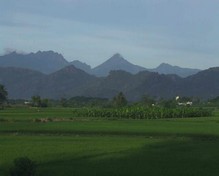Agasthya
A newsletter on the Natural History, Ecology
and Conservation of the Agasthyamalai region, Western Ghats, India.
Any and all opinions expressed in this newsletter are solely those of the author(s) and do not reflect the opinion of ATREE.
A S H O K A T R U S T F O R R E S E A R C H I N E C O L O G Y A N D T H E E N V I R O N M E N T
Digging beneath the plasticky concern
- Jahnavi G Pai
It seems like elements of our life are being taken apart bit by bit, and sold back to us in attractive packages. From education to holidays, computers to “eco-friendly” organic vegetables, from baby showers to funerals, many unimaginable things come in packages that suit different pockets. Thus, the most sought after packaging material – the plastic bag – has today become part and parcel of our existence.
The plastic bag has not spared the gods too. They aren’t yet selling religion in a plastic bag but all its components have been engulfed by it. Having wrapped the religious offerings, hymns and prayers at temples, it is now on its way to take in the festivities at homes.
It is no wonder that the plastic menace reaches such alarming proportions at the Sorimuthaian temple during the annual Aadi amavasai festival. The all-pervading plastic cannot possibly evade a “protected area” too. What caught the attention of the forest department officials who asked ATREE to take up the issue was the improper disposal of plastic bags that were strewn all over the forest floor. It is also no wonder that while dabbling with the plastic issue, we realised that the litter was only a symptom of a disease that lies deeper – the disease of commodification.
Commodification and all its fallouts coupled with ignorance can spell doom when it enters a fragile ecosystem. It might still be possible to clean up the soil and the river of the plastic mess but would it ever be possible to tackle the underlying disease that is probably the root cause of everything that ails the environment today? What is probably worse is that the very forces that cause degradation in one place are the ones that pay for cleaning up the mess elsewhere. This has been my only reason for protesting against fund-raising in malls. In Bangalore alone, thousands of trees are being razed down to support malls and the lifestyle they promote. To me, fund-raising in malls means promoting a false notion among people that they have “done their bit” to nature. Why, it even amounts to commodifying redemption.
However, I also feel helpless about not being able to come up with a better alternative for raising funds without which the campaign can never take place. Finding myself in this sticky situation where principles and action cannot converge, I ask if conservation and commodification are two faces of the same coin. Can forests be conserved unless polluters who fund conservation projects realise that mere paying up will not really help the cause?
Centre for Excellence in Conservation Science
Royal Enclave,Srirampura,Jakkur Post
Bangalore-560064
Telephone: 080-23635555 (EPABX)
Fax : 080- 23530070
Editorial Team
Editor: M. Soubadra Devy
Associate editor: Vivek Ramachandran
Editorial Review: R. Ganesan, T.Ganesh
Design and presentation: Vivek Ramachandran






